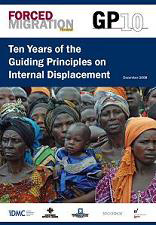INTRODUCTION
At the time that the Guiding Principles were drawn up, the right of IDPs to reclaim abandoned property was not beyond dispute. Human rights law guaranteed a “right to return” but it was limitd to restoring people to the frontiers of their country of origin — a destination often far from their actual homes. Likewise, the right to legal remedies for violations such as property confiscation was defined as a procedural entitlemetn to a fair hearing, without pre-judging whether any specific substantive remedy such as restitution should result.
Accordingly, while the drafters of the Guiding Principles were aware that durable solutions for IDPs were inconceivable without the possibility of restitution and voluntary return, prevailing legal understandings necessitated a formulation focusing on state duties rather than individual rights. However, important progress on the ground came as a result of the 1995 Dayton Peace Accords, which ended the war in Bosnia and included rights for displaced persons “freely to return to their homes of origin” and to “have restored to them property of which they were deprived.” The next five years saw a methodical push to restore the property rights of Bosnia’s displaced, resulting in the restitution of some 200,000 homes, the return of up to a million people and the first real precedent for large-scale post-conflict property restitution as of right.
 |
This article appears in a 40-page special issue of FMR that reflects discussions at the international conference on the Ten Years of the Guiding Principles on Internal Displacement – GP10 – held in Oslo on 16-17 October 2008. It will be available in English, Arabic, French and Spanish. The English edition is now online at http://www.fmreview.org/GuidingPrinciples10.htm |
The Brookings Institution is committed to quality, independence, and impact.
We are supported by a diverse array of funders. In line with our values and policies, each Brookings publication represents the sole views of its author(s).



Commentary
Guiding Principle 29 and the Right to Restitution
December 31, 2008